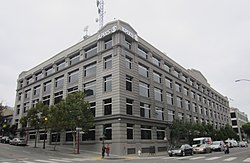KZDG
Established in 1947 at San Mateo as KSMO, the station ran into a turbulent history between 1951 and 1961 with a myriad of financial and labor union issues.
CBS Radio/Entercom originally leased out the station to Factorial Broadcasting from 2011 to 2018, where it carried a South Asian format under the "Radio Zindagi" name and KZDG calls.
This format and call sign returned in January 2022 when Zindagi operator Factorial Broadcasting entered another lease arrangement, ultimately agreeing to purchase the station.
On March 20, 1946, the Federal Communications Commission granted Amphlett Printing Company, publisher of The Times newspaper, a construction permit for a new 1,000-watt radio station on 1550 kHz at San Mateo.
[20] However, even this arrangement was challenged by other stockholders in Bay Radio, who demanded an accounting of the station's operations under Cisler's management[21] and sought to take over operations themselves to retain the "good music" format; negotiations were even reopened with several potential suitors, including Calvin Smith, president of KFAC, the classical music station in Los Angeles.
[23] Further adding to KEAR's woes, the IRS filed a second tax lien on the station, this one in San Mateo County, which would have allowed a federal seizure of the transmitter facility.
[31] The tax lien was finally lifted in mid-July, but the specter of more labor trouble moved in to take its place, as a stalemate threatened to develop with NABET.
[32] The dispute finally resulted in a strike on September 24, almost eight months after the contract expired; while Cisler hoped to resume broadcasting later the same day,[33] he then opted to keep both stations shut down to prepare to the transfer to Segal.
[46] Months later, the United Press International wire service sued Gordon for $1,700 in unpaid fees and to collect the remaining $15,000 of a five-year contract.
The launch had been delayed two weeks[48] due to more trouble with NABET, which occurred when Atlass refused to hire 18 employees that Gordon had dismissed upon taking the station silent.
Continued NABET woes—which were not solved until seven employees were reinstated in February[50]—and low ratings led to Atlass offering several commercials for the price of one, which did little to attract interest.
[54] The Buckley-Jaeger Broadcasting Company purchased the KKHI stations for $750,000 in September 1963, stating their intention to retain the format;[55] the FCC approved the transaction in March 1964.
[57] In the case of the San Francisco operation, Buckley alleged that splitting the two frequencies would require a one-time $23,000 expenditure on infrastructure and cost $67,000 a year.
[58] The stations vigorously fought the new regulation; the FCC ordered them to come into compliance effective August 1, 1967, which was met with a lawsuit in federal appeals court.
[59] The rule was upheld in an opinion written by future Chief Justice Warren E. Burger;[60] the stations would eventually get a waiver in 1972,[2] as some other classical operations received similar authorization.
[66] In November 1993, Buckley announced the sale of KKHI-AM-FM to Group W, the owners of KPIX-TV, for $14.2 million, setting off immediate speculation about a format change.
[70] At Grey Rock, the KPIX studios at 855 Battery Street, a new combined newsroom was built to integrate the television and radio news teams.
While the combined holdings of the two companies in San Francisco did not require the divestiture of any radio properties in the market, it did bring KPIX under common ownership with another of its all-news competitors: KCBS.
[84] On May 17, 2007, CBS flipped sister station KIFR from the "Free FM" hot talk format to oldies with call sign KFRC-FM.
One month later, three of KIFR's former programs debuted on KYCY, in part to fulfill contractual obligations for hosts like Adam Carolla to be cleared in the San Francisco market.
The station was increasingly a collection of disparate programs: an attempted financial talk format, the A's, and audio simulcasts of KPIX-TV's morning news, with the podcasts continuing to air on weekends.
[88] Unlike KFRC-FM's locally-based iteration of the format, this KFRC was largely programmed via satellite through Citadel Media's "The True Oldies Channel", hosted by Scott Shannon.
[89] KFRC's oldies format ended on September 1, 2011, when the station was taken over by Cinemaya Media under a time-brokerage agreement; the classic hits programming remained online and on KFRC-HD2.
[104] The power level is 10 kW, and the antenna system is a three-tower directional array with a tower height of 46.9 meters located at coordinates 37°31′59″N 122°16′31″W / 37.533093°N 122.275347°W / 37.533093; -122.275347.
[106] The transmitter site is surrounded by O'Neill Slough, which is part of the San Francisco Bay tidal estuary in a spartina cordgrass area and clapper rail habitat.




